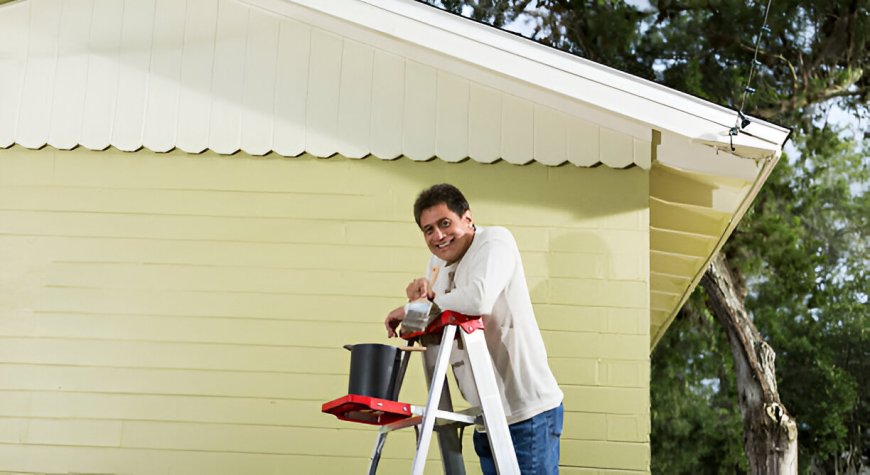Seasonal Guide: The Best Time of Year to Paint Your House
Learn the best time of year to paint your house. Explore the ideal weather, temperature, and season for exterior painting to ensure the best results.

When it comes to painting your home exterior, timing is everything. The best weather for exterior painting can make a huge difference in how well your paint job holds up over time. The right conditions not only improve the quality of your paint job but also ensure it lasts longer and dries properly.
In this seasonal guide, well explore the ideal season for house painting, factors like house painting temperature, and tips on when to paint your house exterior for the best results. Whether youre considering painting house in summer or fall, youll learn everything you need to know to make an informed decision.
Best Time of Year to Paint Your Home
1. The Ideal Temperature for Painting
When it comes to exterior painting, the house painting temperature is crucial. Paint needs to dry properly, and extreme temperatureseither too hot or too coldcan prevent it from curing correctly. So, when is the best time of year to paint your home?
The ideal temperature range for exterior painting is typically between 50F and 85F (10C to 29C). This range allows the paint to dry evenly without risking premature cracking or peeling. If it's too hot, the paint may dry too quickly, which can cause it to peel or crack. If it's too cold, the paint may not dry properly, leading to issues with adhesion and durability.
Tip: Avoid painting during the early morning or late evening when temperatures may drop significantly.
2. Spring and Fall: The Best Seasons for Exterior Painting
The ideal season for house painting is often fall or spring. These seasons offer moderate temperatures and low humidity levels, which are perfect for painting.
Spring is a great time to paint because temperatures are rising, but its not too hot, and the air is generally dry. This makes for ideal conditions for paint to adhere properly.
Fall is also an excellent time to paint because the temperature is comfortable, and the humidity is lower. The cooler air also allows the paint to dry slower, which can help achieve a smooth, even finish.
Tip: Avoid painting during summers peak heat, especially if you live in areas where temperatures exceed 90F (32C), as this can cause the paint to dry too quickly, resulting in streaks and a rough finish.
3. Summer: Pros and Cons of Painting in Hot Weather
While summer can be a good time to paint, its not always the best time to work on your homes exterior. The heat can cause the paint to dry too quickly, which leads to poor adhesion and visible brush marks.
However, if you're painting a surface that doesnt directly face the sun, or if your painting project is limited to smaller areas that wont be affected by the heat, summer can still work. In areas where summers are less extreme, outdoor paint timing might be more flexible.
Tip: If you must paint in summer, try to paint during the cooler parts of the day, such as early morning or late evening, to avoid excessive heat and humidity.
4. Winter: Why Its Not Ideal for Exterior Painting
Most professionals recommend not painting in winter because cold weather affects paints ability to dry and adhere properly. If you live in a region where temperatures regularly fall below freezing, winter is the worst time to paint.
In colder temperatures, paint can freeze, causing it to become lumpy or uneven. Additionally, winter weather can introduce moisture that interferes with paints adhesion and finishing.
Tip: If you're absolutely set on painting during the winter, ensure that temperatures stay above 35F (1.6C) consistently for the duration of your project.
Outdoor Paint Timing: When Is the Right Time to Paint Your House?
1. Avoid Painting in Wet Conditions
Its important to keep an eye on the forecast. If rain or high humidity is expected, its best to wait. Outdoor paint timing is about more than just temperaturemoisture plays a huge role in whether or not your paint will adhere properly. Wet conditions can wash away freshly applied paint or cause it to dry too slowly.
Tip: Wait for a dry period to ensure the paint can cure properly. If it rains soon after your project, you may end up with a blotchy or uneven finish.
2. Planning Your Paint Job: Ideal Weather Conditions
To ensure your paint job looks as good as it can, try to pick paint color for your bedroom or any room during times of mild weather. Mild temperatures and low humidity are essential to achieve a smooth, flawless finish.
Tip: Always follow the paint manufacturers instructions. These often include guidelines on ideal temperatures and humidity levels, which will help you decide on the best time of year to paint your home.
Conclusion
Understanding the best time of year to paint your home ensures that your paint job will last and look great. The ideal season for house painting is typically spring or fall, when temperatures are moderate and humidity is low. By following the right conditions for house painting temperature and avoiding extreme weather, you can ensure your exterior paint dries properly and adheres securely.
If you're unsure about when to start your exterior painting project or need expert help with outdoor paint timing, reach out to the professionals at Ayers Painting for guidance and a quality finish. Visit Ayers Painting today to learn more.
For more helpful tips on when to paint your house, check out this article: When to Paint Your House: Seasonal Timing Guide.






























